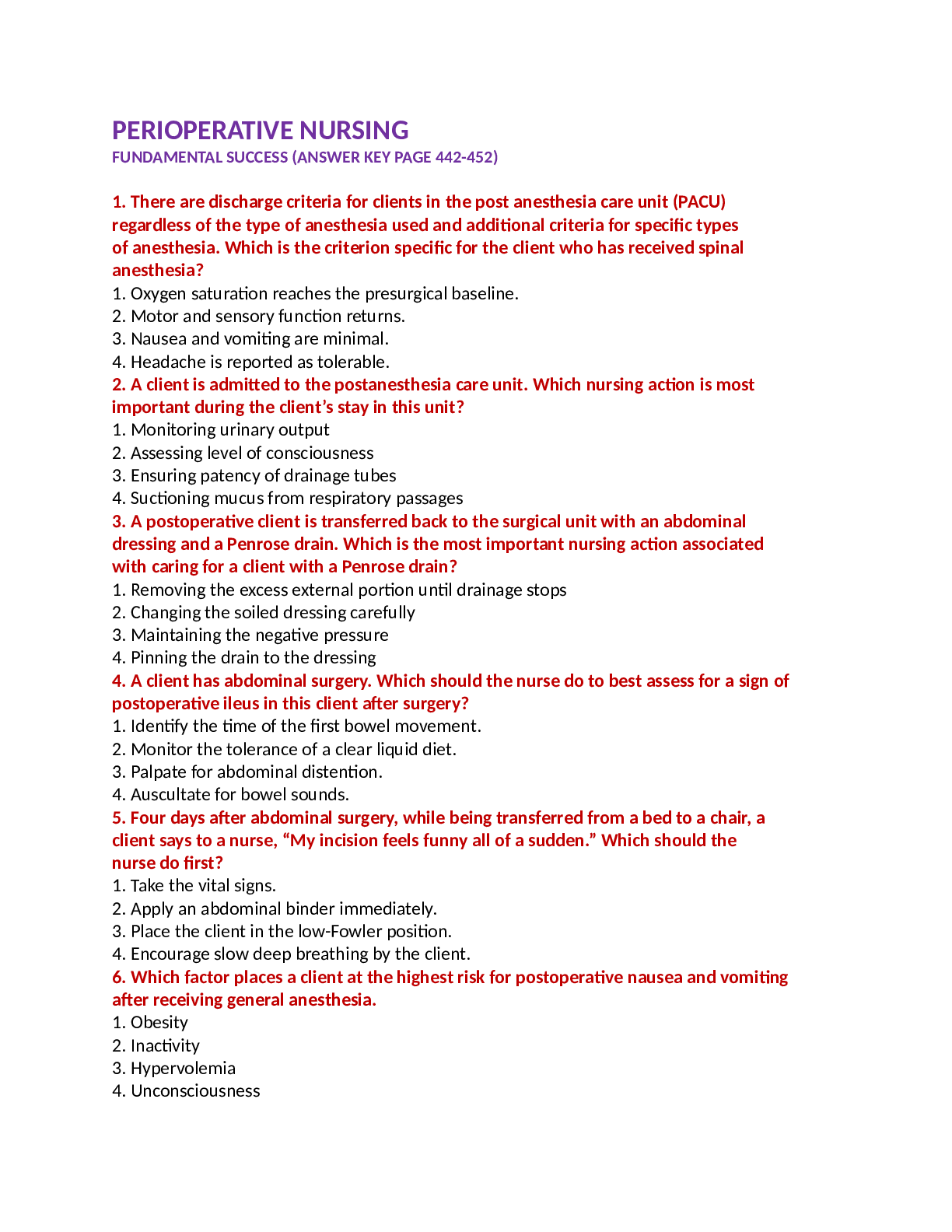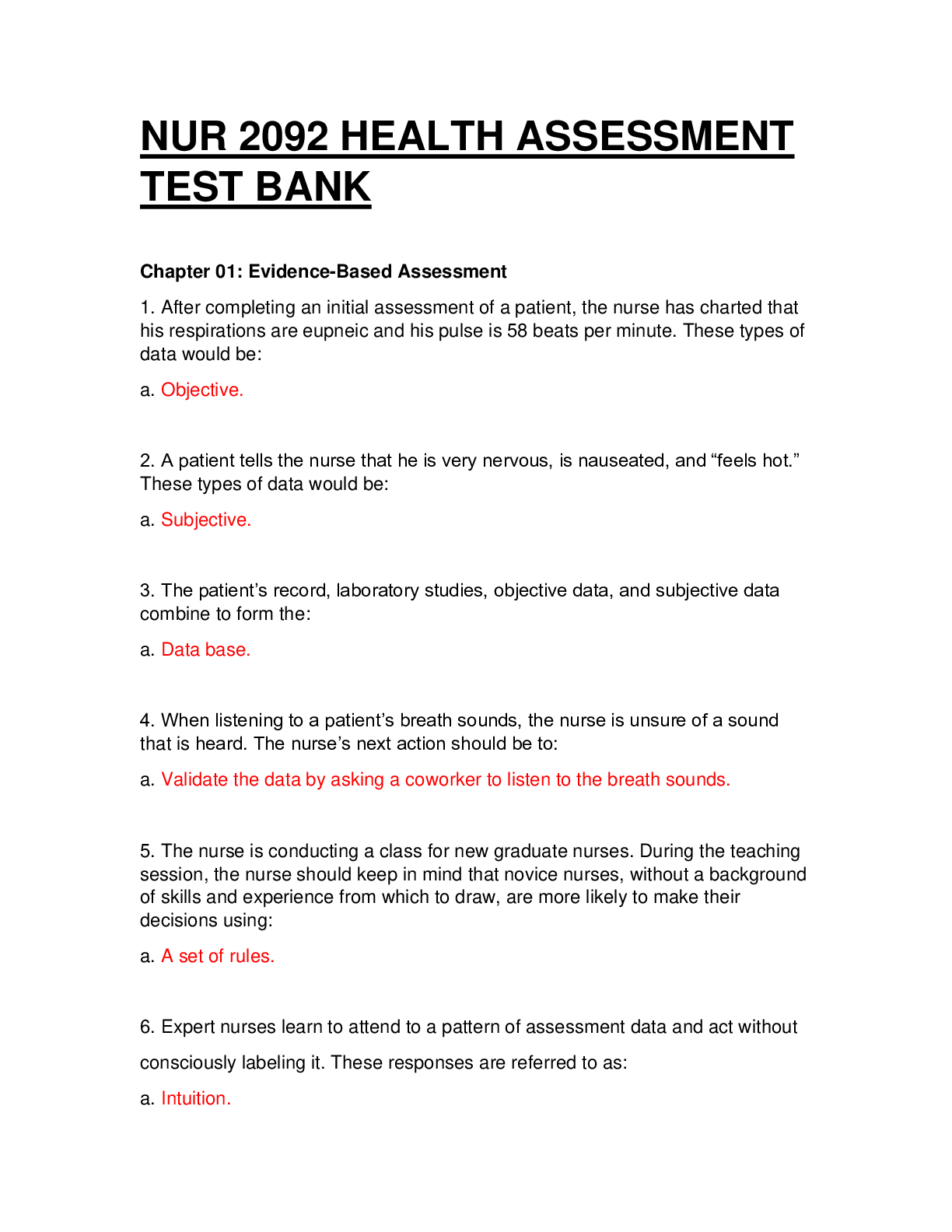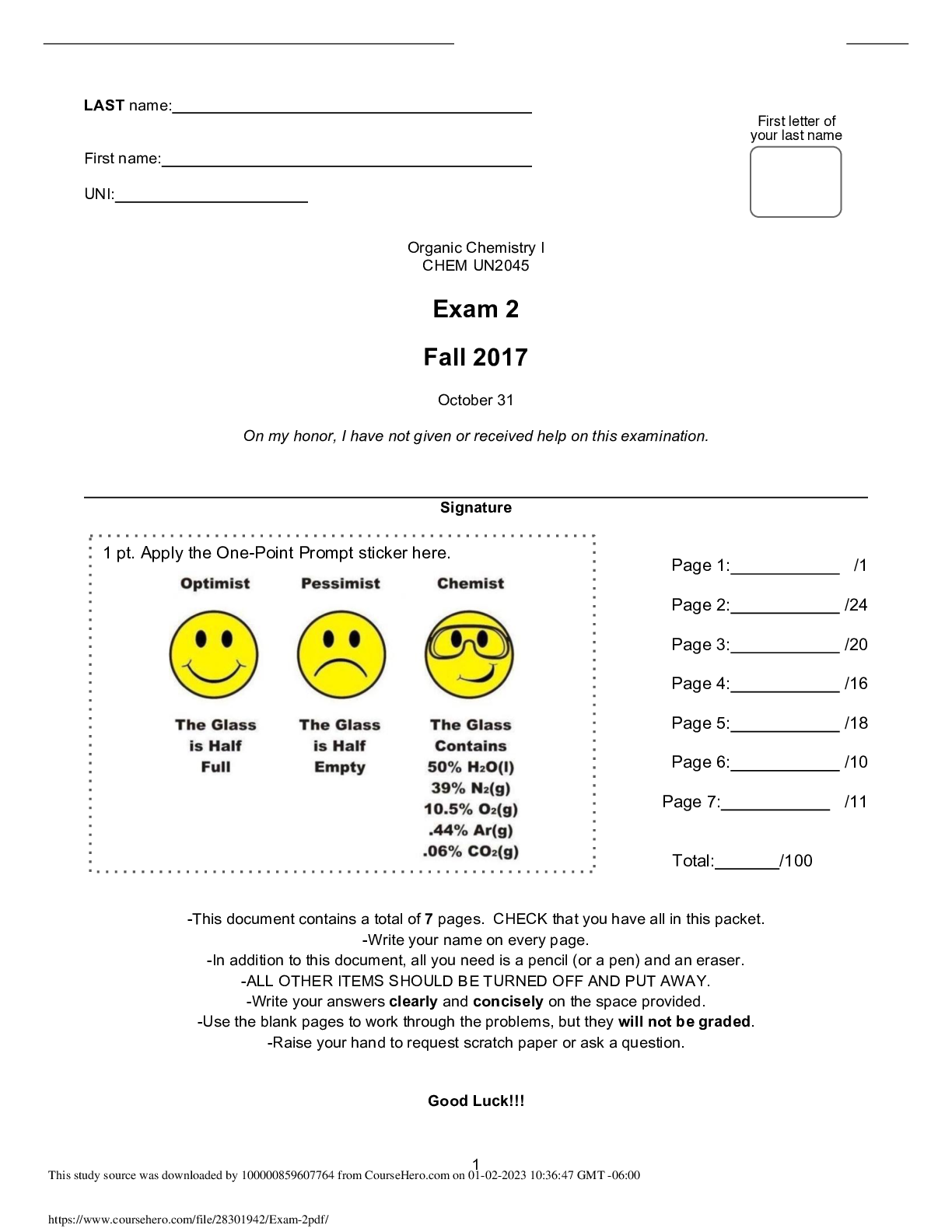Pathophysiology > QUESTIONS & ANSWERS > OUR LADY OF LAKE UNIVERSITY, Ch 7 Pathophysiology Test Bank. ACCURATE ANSWERS. GRADED A+ (All)
OUR LADY OF LAKE UNIVERSITY, Ch 7 Pathophysiology Test Bank. ACCURATE ANSWERS. GRADED A+
Document Content and Description Below
Multiple Choice Identify the choice that best completes the statement or answers the question. ____ 1. Neutrophils: a. are phagocytic cells. b. produce histamine. c. produce antibodies. d. are e... levated during an allergic response. ____ 2. Which cells are required to process and present antigens from foreign material as the initial step in the immune response? a. T–helper cells b. Macrophages c. Eosinophils d. Monocytes ____ 3. Humoral immunity is mediated by: a. natural killer cells. b. T lymphocytes (T cells). c. B lymphocytes (B cells). d. neutrophils. ____ 4. A secondary immune response differs from the primary immune response in that: a. it is more rapid than the primary response and results in higher antibody levels. b. it is slower than the primary response and doesn’t change the antibody levels. c. it occurs at the same time as the primary response but results in a decrease in antibodies. d. it only occurs in hyperallergic reactions and results in a decrease of antibodies. ____ 5. Which type of immunity is provided by a vaccination? a. Active natural b. Active artificial c. Passive natural d. Passive artificial ____ 6. When an allergen binds with IgE antibodies on mast cells, resulting in release of chemical mediators, this reaction is called: a. cytotoxic hypersensitivity. b. immune complex hypersensitivity. c. type I hypersensitivity. d. type IV hypersensitivity. This study source was downloaded by 100000773243632 from CourseHero.com on 03-25-2022 02:54:22 GMT -05:00 https://www.coursehero.com/file/17566427/Ch-7-Pathophysiology-Test-Bank/ ____ 7. The role of memory cells is to: a. change into an antibody-secreting cell following activation. b. immediately secrete antibodies following the first exposure to antigen. c. recognize the antigen and stimulate the immune response. d. bind complement to the antibody. ____ 8. Which statement applies to contact dermatitis? a. It occurs when IgE antibodies on the skin react with the causative substance. b. It may result from ingested foods. c. Urticaria (hives) gradually spread over the body. d. A type IV reaction occurs in affected areas. ____ 9. Which of the following causes anaphylaxis? a. A severe, systemic allergic reaction b. Type III hypersensitivity c. Cell-mediated hypersensitivity d. Immune complex deposits in many tissues ____ 10. Following a positive HIV antibodies blood test and ELISA test, what is the test commonly used for confirmation? a. Agglutination b. Double immunodiffusion test c. Western blot test d. Sedimentation rate test ____ 11. Incompatible blood transfusions result in: a. hemolysis of erythrocytes. b. a type I immune response. c. deposits in multiple organs. d. immune deficiency. ____ 12. An autoimmune disease is: a. excessive formation of antibodies following exposure to foreign material. b. an extreme response to normally harmless material in the environment. c. an abnormal response to ingested food and drugs. d. failure of the immune system to distinguish self from nonself. ____ 13. Systemic lupus erythematosus is caused by: a. a chronic allergic condition. b. development of an immune-deficient state. c. a deficiency of T lymphocytes. d. immune complex deposits of antinuclear antibodies. ____ 14. Distinguishing clinical features of systemic lupus erythematosus include: a. inflammation in multiple organs. b. lack of a specific diagnostic blood test. c. acute onset and nonprogressive course. d. typical skin rash on the chest and back. This study source was downloaded by 100000773243632 from CourseHero.com on 03-25-2022 02:54:22 GMT -05:00 https://www.coursehero.com/file/17566427/Ch-7-Pathophysiology-Test-Bank/ ____ 15. Which of the following are the target cells for HIV? a. Helper T lymphocytes (CD4 lymphocytes) b. B lymphocytes c. Natural killer cells d. Macrophages ____ 16. A diagnosis of HIV positive means that: a. the number of T lymphocytes in the circulating blood is decreased. b. significant opportunistic infection is present in the body. c. the individual has AIDS. d. the virus and its antibodies are present in the blood. ____ 17. HIV infection impairs: a. humoral immunity. b. cell-mediated immunity. c. both humoral and cell-mediated immunity. d. neither type of immunity. ____ 18. Immunodeficiencies may result in an increased risk of infections by normally harmless microorganisms. These infections are referred to as: a. opportunistic. b. prophylactic. c. abnormal. d. transient. ____ 19. Serious infections frequently occurring in patients with AIDS include: 1. tuberculosis. 2. Pneumocystis carinii pneumonia. 3. influenza. 4. tetanus. a. 1, 2 b. 1, 4 c. 2, 3 d. 3, 4 ____ 20. Which of the following statements does NOT apply to major histocompatibility complex (MHC) proteins or molecules? a. They are genes on chromosome 6. b. All members of a family have identical MHCs. c. They alert the immune system to virus-infected cells. d. A close match is essential for successful tissue transplants. ____ 21. CD4-positive helper T cells function by: a. direct cytotoxic action. b. facilitating all immune system activity. c. producing immunoglobulins. d. inactivating allergens. This study source was downloaded by 100000773243632 from CourseHero.com on 03-25-2022 02:54:22 GMT -05:00 https://www.coursehero.com/file/17566427/Ch-7-Pathophysiology-Test-Bank/ ____ 22. Host-versus-graft disease refers to: a. hyperacute rejection of tissue. b. T cells in grafted tissue attacking host cells. c. infection resulting from immunosuppression therapy. d. transplant rejection by the recipient’s immune system. ____ 23. Which of the following complications does NOT occur frequently in AIDS patients? a. Kaposi’s sarcoma b. Wasting syndrome c. Lymphoma d. Polyarthritis ____ 24. Which of the following characteristics apply to HIV? 1. It contains two strands of DNA. 2. It tends to mutate frequently to form new strains. 3. The incubation period is extremely short. 4. It is inactivated by heat and many disinfectants. a. 1, 2 b. 1, 3 c. 2, 4 d. 3, 4 ____ 25. In cases of HIV infection, the “window period” refers to the time between: a. entry of the virus into the blood and the initial manifestations. b. entry of the virus into the body and the appearance of antibodies in the blood. c. entry of the virus into the body and a significant drop in CD4 T-helper lymphocyte count. d. diagnosis of “HIV positive” and diagnosis of “AIDS.” ____ 26. Which of the following is an effect of cytokines? They: a. activate and stimulate proliferation of B and T lymphocytes. b. destroy antigens quickly. c. increase the rate of mitosis in tumors. d. cause immediate pain. ____ 27. What does seroconversion mean in relation to HIV and AIDS? a. The virus has been identified in the blood and body fluids. b. Antibodies for HIV have been identified in the blood. c. HIV was found in lymphocytes. d. Active infection has developed in the patient [Show More]
Last updated: 1 year ago
Preview 1 out of 6 pages
Instant download
.png)
Buy this document to get the full access instantly
Instant Download Access after purchase
Add to cartInstant download
Reviews( 0 )
Document information
Connected school, study & course
About the document
Uploaded On
Mar 25, 2022
Number of pages
6
Written in
Additional information
This document has been written for:
Uploaded
Mar 25, 2022
Downloads
0
Views
32

.png)
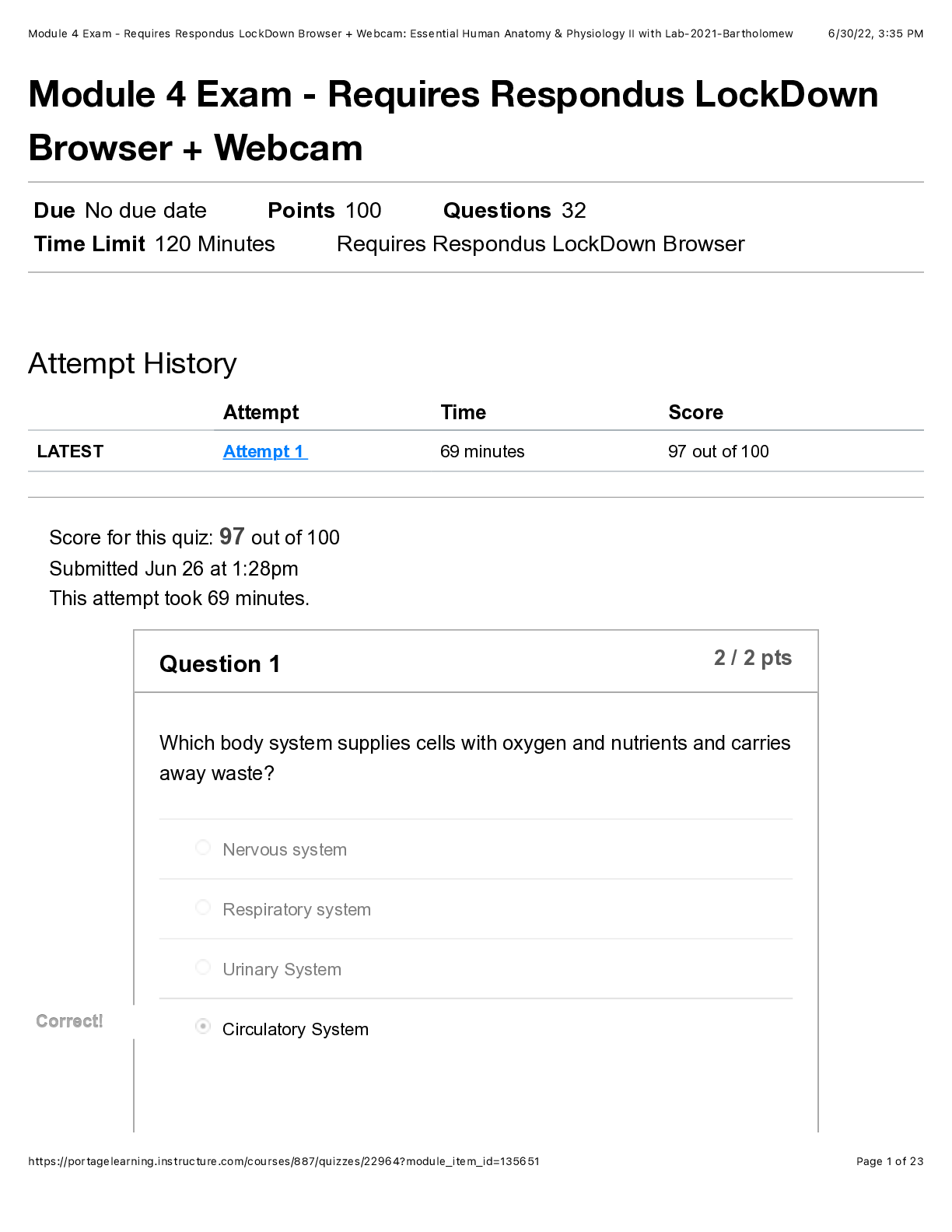
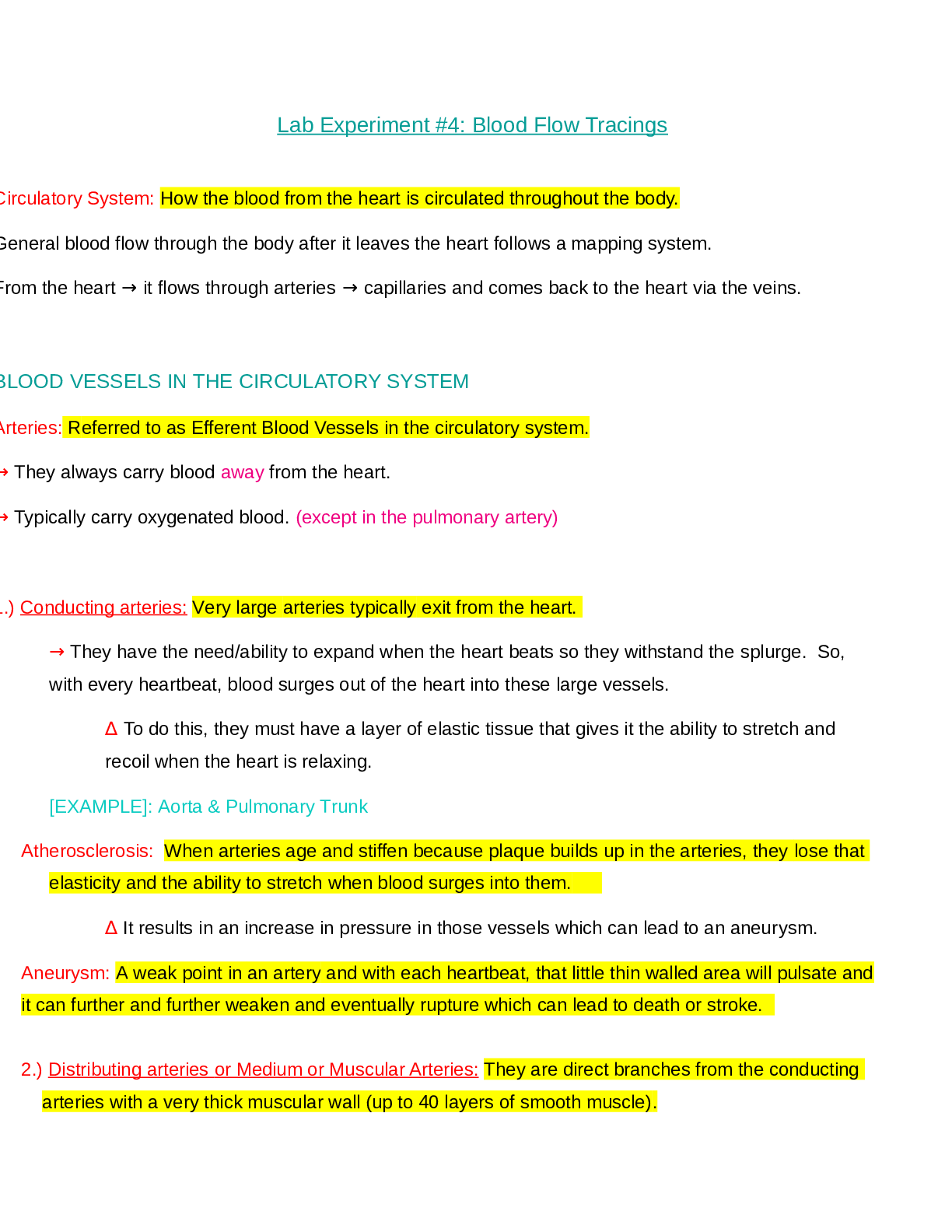

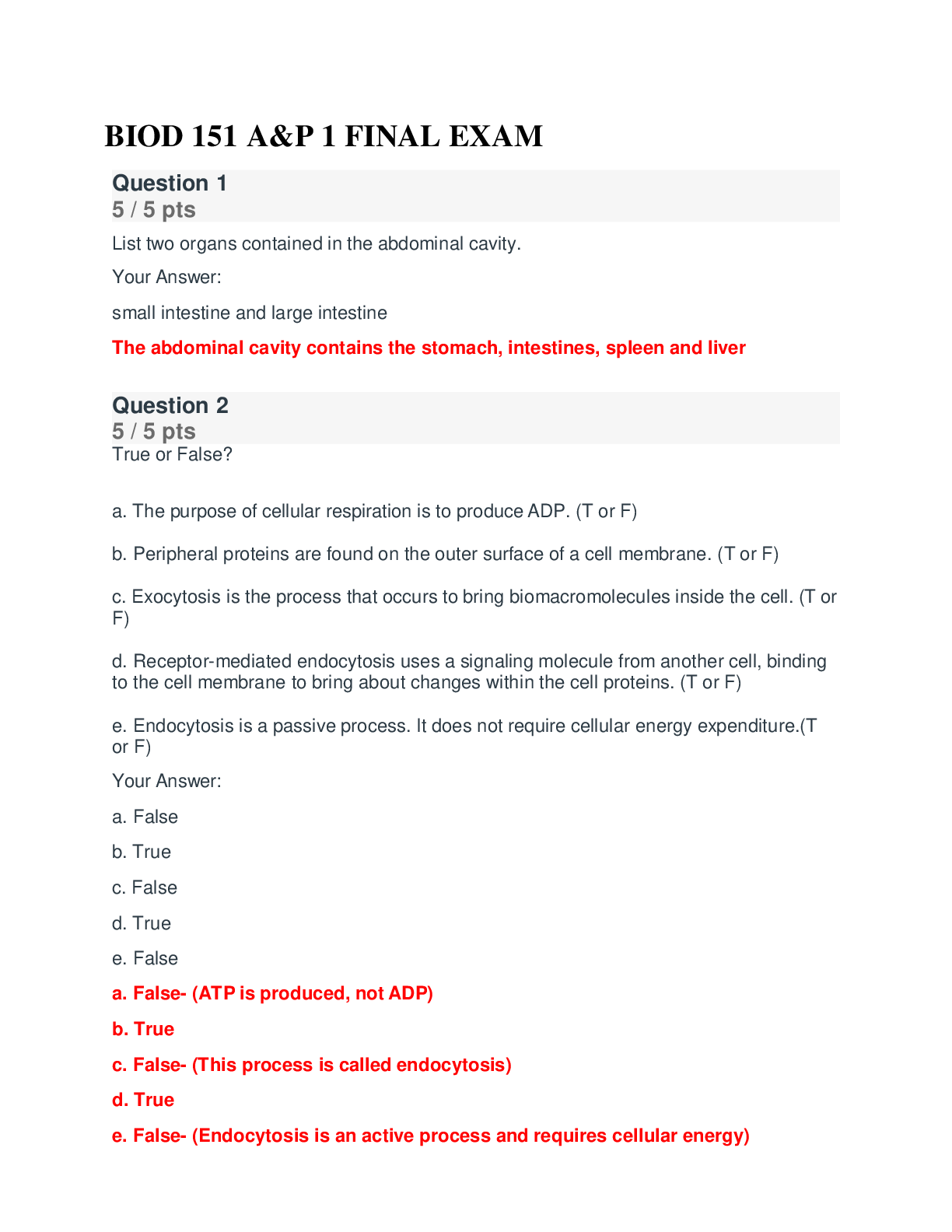
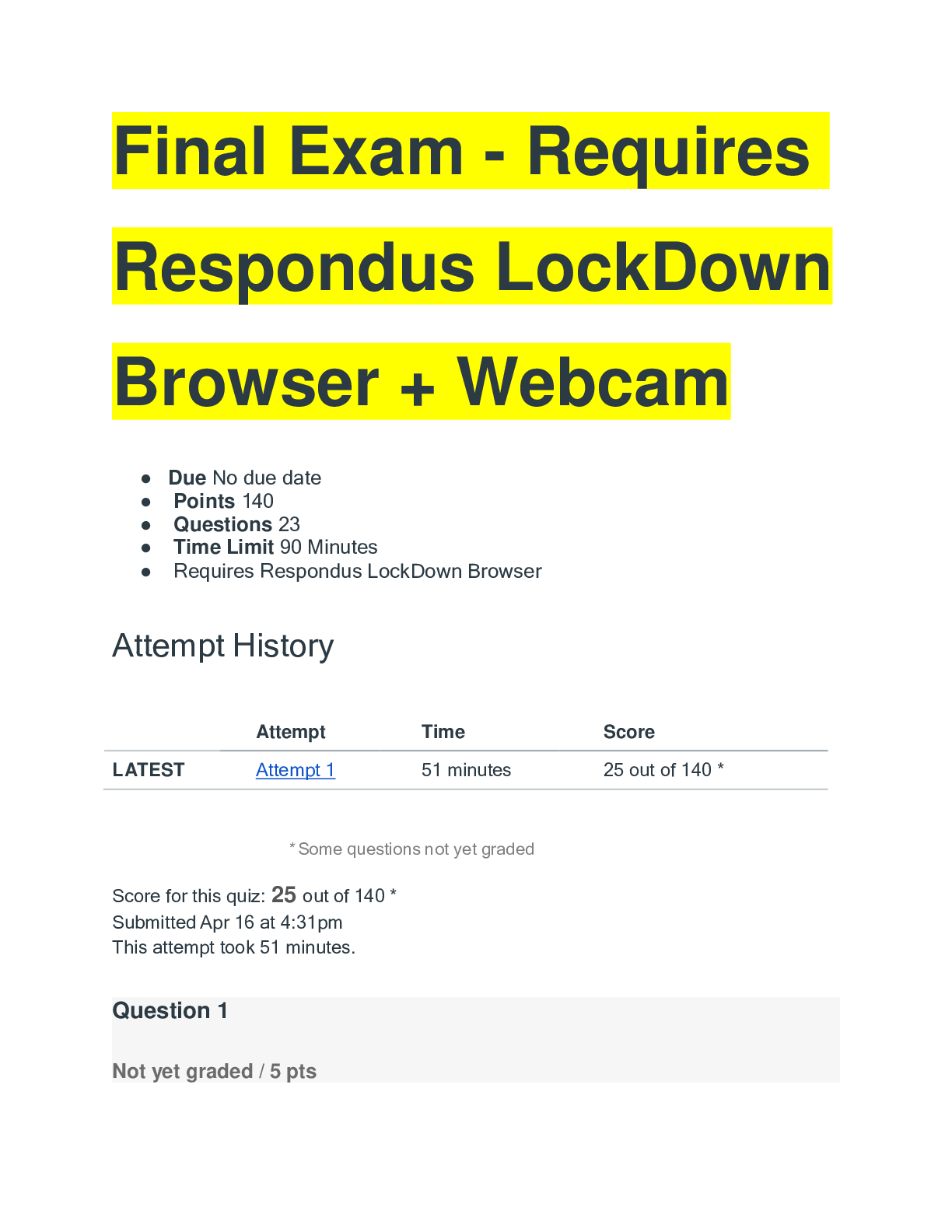


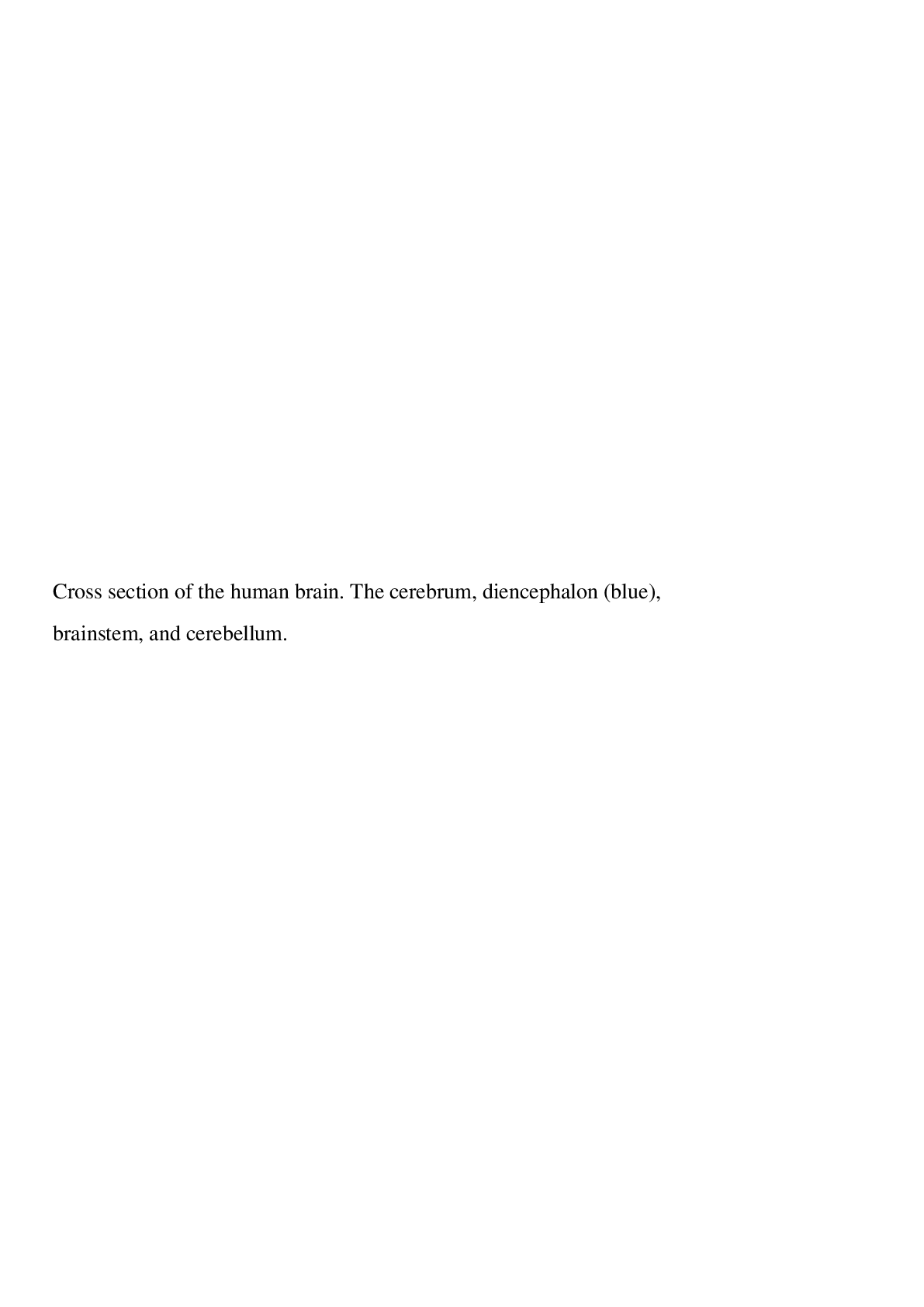
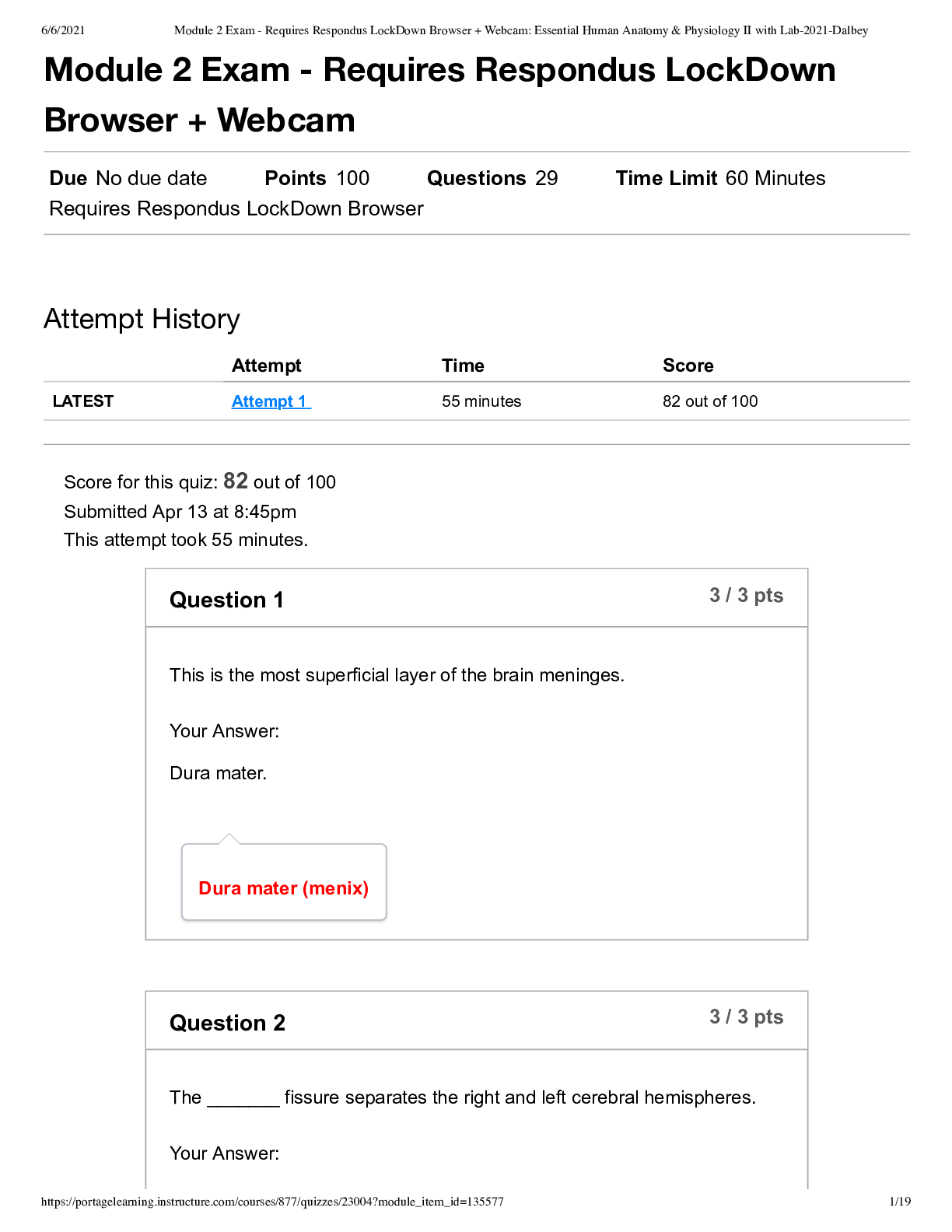
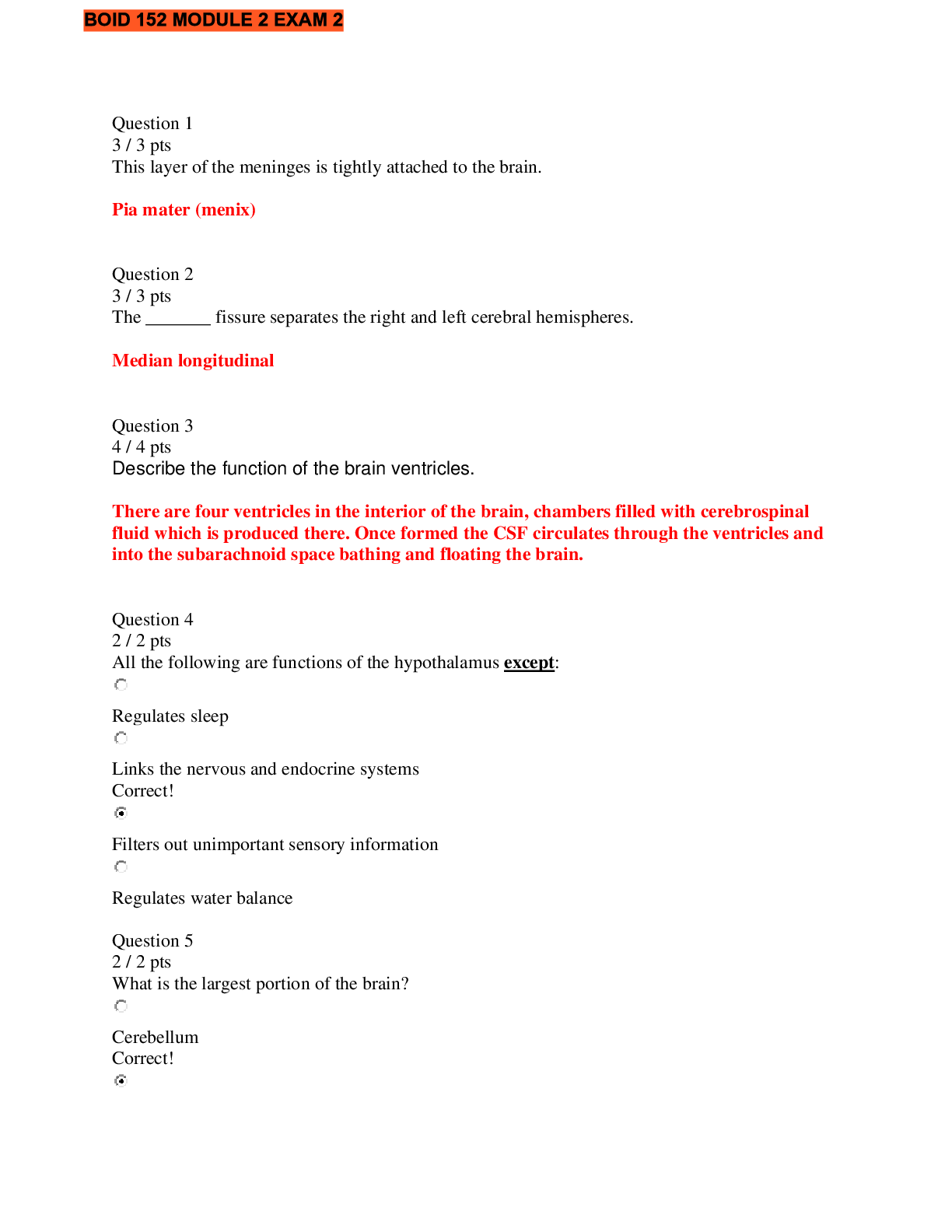

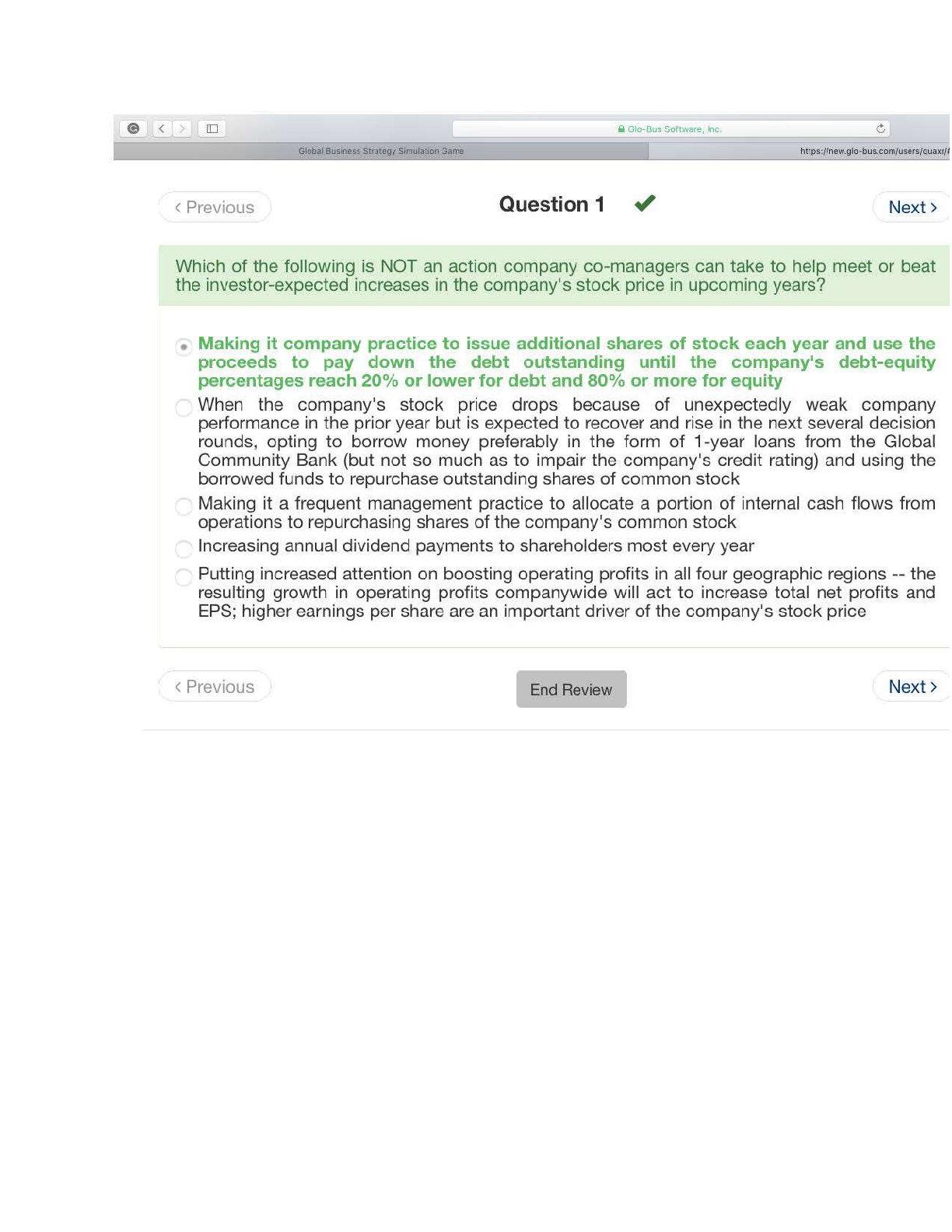





 (1).png)
